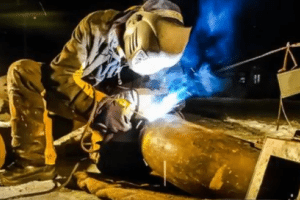
Welding Rod Fumes Poisoning Lawsuits. Manganese is a common metal used in welding in order to create steel. Welding joins pieces of metal by the use of heat and/or pressure. Welding is one of the most dangerous industrial activities. In addition to Manganese poisoning from toxic fumes, the dangers of welding include metal fume fever, […]
 Welding Rod Fumes Poisoning Lawsuits. Manganese is a common metal used in welding in order to create steel. Welding joins pieces of metal by the use of heat and/or pressure. Welding is one of the most dangerous industrial activities. In addition to Manganese poisoning from toxic fumes, the dangers of welding include metal fume fever, fire, electric shock, compressed gases, and injury to the eyes, hands, feet, lungs, heart, kidney, and central nervous system.
Welding Rod Fumes Poisoning Lawsuits. Manganese is a common metal used in welding in order to create steel. Welding joins pieces of metal by the use of heat and/or pressure. Welding is one of the most dangerous industrial activities. In addition to Manganese poisoning from toxic fumes, the dangers of welding include metal fume fever, fire, electric shock, compressed gases, and injury to the eyes, hands, feet, lungs, heart, kidney, and central nervous system.
Manganism results from damage to the basal ganglia area of the brain, which controls many movement and motor control signals. Manganese poisoning symptoms may include: tremors, muscle stiffness, rigidity, instability and lack of balance, slowness of movement, joint pain, cramps, memory loss, partial paralysis, drooling, difficulty swallowing and constipation. There is no cure for manganism. In order to treat it successfully, it must be caught early when cessation of manganese exposure is still possible. Manganese-induce Parkinsonism does not typically respond to Parkinson’s disease medications such as Levodopa.
Welding requires an enormous degree of precautionary measures because the risks of injury are extremely high. Fumes are a natural by-product of welding, and are expected from even simple welding operations. Even simple welding work should require the use of respiratory protection or ventilation. Simple operations lead to fumes like carbon monoxide, nitrogen oxide, and ozone. Extra precautions must be taken when welding metal coated with or containing zinc, cadmium, chromium, copper, fluoride, lead, manganese, or vanadium, because the resulting fumes can cause a condition known as metal-fume fever. Another serious concern is working with metal that has been coated or painted.
Many of the paints that have coated metal are lead based; lead is a known carcinogen. Employers are required to provide well-ventilated workspaces so that manganese fumes do not reach toxic levels. They are also required to provide personal protective equipment such as respiratory masks and protective suits and gloves. Welding rod manufacturers should adequately warn welders about the hazards associated with their products. Failure to meet OSHA occupational safety standards and failure to warn about dangerous welding rod products may mean that your employer or the welding rod manufacturer could be found negligent.
If you or a loved one developed manganism or other injuries from welding rod fumes, you have legal rights. Please fill out the form at the right for a free case evaluation by a qualified welding rod attorney. Alternatively, call 1-800-YOURLAWYER (1-800-968-7529) to speak to someone at our firm.


